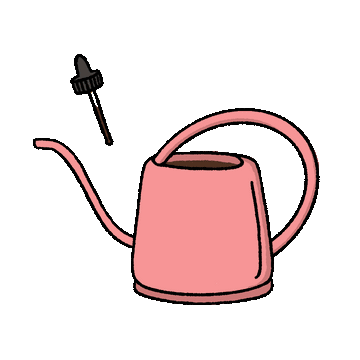You've picked your plant, now it's time to house it. Picking the 'right' pot for your plants can be crazy overwhelming. You've got aesthetics, material, pot size and price all to consider, and then just when you think you've settled on something you realise it doesn't have any drainage holes. Hopefully this post helps make that pot-picking process a little less...potty.
I've laid out this post the same way I approach my pot-purchasing. Obviously this isn't a hard and fast guide - We're all for the "love this pot I'll find a plant for it later" approach - but it should help!
Decision One: Pot Size
This one is simple. If its a new plant that's not root bound (some plants have been hanging out in their plastic pot a little too long) you want to pot it a pot the same size as the one you bought it in.
If the pot is too large, the potting media will dry slower and the plant will be more susceptible to root rot. If its too small, you may damage the root ball getting it in there and then you'll have to be super conscious of making sure it doesn't dry out too quickly.
If your plant is ready to be potted up, make sure the new pot is only one or two sizes up.
Plant Runner Hot Tip: Consider using your pots as covers for the plastic pots the plants come in. This way potting up is so much easier (plastic is easier to manipulate) and you'll be able to more easily move your plants around the home.
Decision Two: Hole or no hole?
We have always referred to pots without drainage holes as Sleeves because you just sit the black plastic pot inside the new pot, so it covers it like a sleeve would. Don't know if thats legit but we're going to stick with it. General consensus is, if you can get a pot with a drainage hole, then do so. It means you can manage your watering better and the plant will be way less prone to root-rot as the excess water can drain out the bottom.
Pots with drainage holes can be a little messy, especially if you haven't got a tray to under it, so consider moving your plants to the shower or bath when watering to allow all the excess water to run down the drain instead of your bookshelf.
That being said, there are a few good reasons to go with a Sleeve.
- Easy to mix it up and change plant/pot combos
- You might just love the look of the pot despite the lack of a drainage hole
- Way easier to repot - just cut the plastic pot instead of having to try get your pot-bound plant out a ceramic pot without damaging it and/or the plant!
Plant Runner Hot Tip: Don't stress if the plastic pot is too small or too high for its new Sleeve. You can always cut the edge of the black plastic pot so it doesn't show over the top. And if it's too short, think about placing a few pebbles in the sleeve first to raise the height. This will also help you manage overwatering a little better as the plant won't be sitting directly in a pool of water if overwatering does occur.
Decision Three: Material; and Decision Four: Aesthetics
We've put these two decisions together because they are so intertwined. You'll definitely need to consider the pot material, but if its not your vibe you definitely won't want to be looking at it in your home all day.
The three most common pot materials?
Plastic, Terracotta, Clay (Ceramic).
Plastic: Light and affordable. Plastic isn't porous so watering won't be as frequent and moisture will be retained longer. They're also way lighter, so great options for hanging baskets or on a wall-mounted shelf. The downside is that they won't always look the part like a glazed or terracotta pot, and, well, they're plastic and will just add to landfill.
Terracotta: Can you go wrong with a terracotta pot? Definitely. But they do look great. They're a versatile medium that can work well with a range of home aesthetics. They age and patina over time giving them a look that you cannot buy. Just remember, terracotta pots are heavy and porous (so more water and air will pass through). So think about what plant you're putting in there and factor that in to how often/little you water it. Terracotta is great for succulents, cacti, and orchids but harder to manage for plants like ferns and aroids.
(Not saying it can't and shouldn't be done though! We are definitely fans of Team Terracotta at the Plant Runner).
Ceramics: Ceramics pots can be glazed or unglazed. Glazed will be less porous, unglazed more so. The big decision here is price. Handmade ceramics are unique pieces of art and you will definitely notice a difference in the price point between them and the factory-produced ceramic pots. But ceramic pots give you the option of finding something that might reflect your personality and your style.
Plant Runner Hot Tip: Always consider all of the above, but remember you can make it work with whatever material you decide on. Some pot choices might mean a little more maintenance, but some pot/plant combos are worth it.



Leave a comment